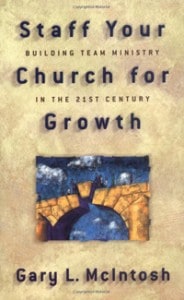 Gary McIntosh’s book, Staff Your Church for Growth, is ambitious in its broad coverage of topics related to developing a team to lead a church—all within the context of the current dynamics of American culture, the size of churches and the evolving needs and expectations of people to whom the church serves.
Gary McIntosh’s book, Staff Your Church for Growth, is ambitious in its broad coverage of topics related to developing a team to lead a church—all within the context of the current dynamics of American culture, the size of churches and the evolving needs and expectations of people to whom the church serves.
Dr. McIntosh is a Professor of Christian Ministry and Leadership at Talbot School of Theology, Biola University, and the author of eighteen books and numerous articles. He is also the President and Principal Consultant of McIntosh Church Growth Network.
While the majority of churches are small with a single pastor, there is a growing number of churches that are becoming larger and adding staff, better ministering to their constituents by adding giftedness, ministry specialization, and enhanced ministry—in place of volunteers.
Strategies for church growth require an understanding of six broad areas:
- Finding people
- Keeping people
- Celebration (worship)
- Educating people
- Overseeing people (direction and planning of ministries)
- Caring for people
Small churches are obviously challenged to do all of these things well, other than having the advantage of a small-community feel with lay volunteers. I am very familiar with this aspect, having been involved in planting three different EV Free churches. We rented schools in all three situations; even though it was a hassle setting up church each week, there was camaraderie of working together to build the ministry. When we moved into a permanent facility, there was almost a sense of loss, even though it was great to have our own place to meet for church and other events. I believe a sense of greater ownership for the ministry by the newer or smaller congregation offsets, to some extent, the lack of more professional pastors to lead all the above components of ministry.
McIntosh provides perspective on the strategy for adding staff and develops the considerations, such as the life cycle of the congregation, current pastor’s gifts, church vision priorities, felt priorities for continued growth, etc. He also introduces the analysis of task orientation versus relational orientation for the role and timing of new hires. All these are good elements for strategic review and planning.
A significant issue in North America is the staffing versus facility funding priorities. McIntosh argues the perspective that an emphasis on staffing is more important for growth of the church. He then provides statistical data to assist with the parameters of FTE (full time equivalent) staff per number in attendance. He settles around the recommendation of one staff position for each 150+ in attendance. The next challenge is to fund this staffing level based on the demographics of the community being served and congregation giving history. As a past banker, I have consulted with numerous churches regarding the ratio of staff cost and facility cost to total budget. In my experience, it is difficult for a church to sustain a combined staff and facility ratio of 70% or more for very long. Appropriate investment in ministry or the development of sufficient cash reserves or maintenance reserves is usually impacted negatively.
I appreciate McIntosh’s book as an ongoing tool for planning; he spends a few pages discussing the pros and cons of hiring from inside the church versus outside the church and part-time versus full-time hires. These types of elements add to the strategic thinking process and are helpful.
Again, the chapter on “Recruiting Staff” has great material for creating checklists; much of the material matches information presented in the lectures of the XPastor Online Course. One of the elements that McIntosh discusses is related to the development of a list of responsibilities and criteria needed for the role we are hiring for, as well as the creation of questions that relate to these elements of criteria that predominately asks for examples from past experience. In this way, we are not comparing a candidate to other candidates but to the criteria we need for the job. Further, we use a matrix that grades alignment to each component and then the overall alignment. We also would weight certain more important elements of priority to determine the appropriate fit and ratio of alignment that would be sufficient. This was a good tool for selecting good hires for the role required.
When it comes to team roles and leadership, McIntosh uses the example of Tribal Chief, Medicine Man, and Chief Executive Officer to describe the various ways leaders may emphasize their leadership. Another description of leadership roles I have heard is Prophet, Priest and King. Both examples are similar as they describe the casting of vision, the caring for people, and the administrative functional aspects of leadership. Another element that often is not understood is the difference between leadership and management—and the need for both, particularly as an organization grows. A short quote from Stephen Covey is helpful: “Leadership deals with vision—with keeping the mission in sight—and with effectiveness and results. Management deals with establishing structure and systems to get those results. It focuses on efficiency, cost-benefit analyses, logistics, methods, procedures, and policies.”
Teaming together with a shared ministry vision is the fun part to me. The leading and management of teams has become an appropriate key aspect of business management and ministry management books, education and consulting. The Bible is full of team relationship examples—the Trinity with each person of the Trinity having different roles, the structure Jethro recommended to Moses, and Jesus and His twelve disciples. McIntosh’s keys to effective teams are clear communication, shared goals, collaborative atmosphere, responsibility and involvement, flexible process, and collegial support. These are elements that I acknowledge would add not only to the effectiveness of the organization but also to the fun or joy to working with a good team.
Leading and nurturing a healthy team is mostly about time; that can be a challenge with all the demands and tasks to be done in a certain timeframe, usually by each Sunday or the next board meeting. Communication and information flow are part of this. I have found that a leader must be intentional about keeping his team informed and helping each one to see how their role and activities tie-in to the vision of the ministry. I have historically scheduled lunch dates with each member of my team and developed the occasional shared event that would allow opportunities together without work being the primary subject. We also tried to celebrate successes together so there was a shared gratification for the teamwork, along with the specific contributions of each member of the team.
To me, management is all about helping individuals and teams be more effective and enjoy the process. This is to facilitate and coordinate the process and projects, with sensitivity to individuals, while bringing focus to the mission that draws the team together. The motivational elements McIntosh proposes for the leader are:
- Focus on the ministry of each staff member, making it challenging and exciting.
- Offer opportunities to staff as individuals and professionals.
- Treat staff as professional partners.
- Allow staff members to influence decisions, particularly in their areas of responsibility.
- Respect the professional status and dignity of each staff member.
- Minimize the burdens and obstacles for the exercise of each staff member’s role.
I like what Max DePree said about leadership: “The first responsibility of a leader is to define reality. The last is to say thank you. In-between the leader is a servant.” Again, McIntosh shares similarly to ask the following:
- Why are we here?—Mission
- Where are we going?—Goals
- How are we doing?—Feedback
- What’s in it for each one?—Rewards
- What happens when we need help?—Support
As noted before, McIntosh covers a broad sweep of issues—such as thoughts on how to disciple your senior pastor boss. His discussion includes:
- Learn what makes your senior pastor tick.
- Listen to your senior pastor.
- Keep your senior pastor informed.
- Speak and write concisely.
- Solve your own problems.
- Give your senior pastor options.
- Do what you say you will do.
- Make your senior pastor successful.
- Represent your senior pastor fairly.
- Be loyal to your senior pastor.
This is a similar list that I have seen represented in business literature related to one’s manager or boss, obviously with different language. In business, there seems to be a greater emphasis on helping your boss be successful and communicating well—in his/her own language or style.
Before McIntosh’s final chapter reviewing future trends, he develops concepts on managing conflict and managing successful teams. This includes elements of organizational development; however “OD” is not a topic he addresses. While McIntosh presents good rudimentary information about the stages of conflict and the various sources or issues that lead to conflict, it is not as expansive as necessary for this topic. In my observation, few managers and organizations handle dissonance well. Therefore, I have done some further study utilizing resources like Crucial Conversations: Tools for Talking When Stakes are High by Kerry Patterson, Joseph Grenny, Ron McMillan, and Al Switzler and the Mediation Training Program, developed by the Institute for Dispute Resolution, Pepperdine University School of Law.
Managing teams is another significant topic that the business community has developed a huge volume of material and consultive resources for, committed to enhancing the practice. McIntosh outlines a good summary of team leadership elements:
- Perception of reality—Seeing what is really going on and living in the present and future.
- Team-building skill—Collaboration that allows for flexibility with good communication.
- Decisive temperament—Quickly making less important decisions and not making more important decisions prematurely.
- Tenacity—Absorption of disappointments while pushing forward.
- Integrity—Engenders trust with character.
- Coaching ability—Supporting team for a healthy environment.
I have also found the following acrostic (for SHEPHERD) I modified from one presented by Theodore Mistra for the “Shepherd/Leader” to be helpful in thinking/praying through leadership of people and teams:
S—Serve others
H—Humility
E—Excellence
P—Persevere with prayer
H—Hear and heal
E—Encourage
R—Respect others
D—Decisions with discipline
In the final chapter McIntosh describes a few trends that he has found important for churches to understand for their continued growth.
- An enhanced understanding of a church’s purpose, vision and values and how these elements can be better developed, communicated and operationally aligned in all aspects of church life and ministry.
- Recognition of a changing environment that requires innovation, flexibility, and new technologies to connect with people in new forms and styles with the timeless message.
- Staff members will need a higher level of skills, competencies and working relationships to stimulate ministry environments that reach people and hold quality staff members.
- Sufficient resources necessary to provide technology and new modes of communication that reaches people almost anywhere and anytime.
- A renewed appreciation for excellent staff members with various ministry specialties and more effective leadership and management for high performing interdependent teams.
I am encouraged by all five of these components that McIntosh challenges us with. They describe well my desire to take management skills into the church and ministry environment for the kingdom effort we are called to as disciples of Christ. I appreciated the book as an ongoing resource to enhance my context for the church and language used by the church. The leadership and management principles and concepts presented were not new or that different from business; however, certainly the vocabulary used is different which is important for more clarity of communication in the church environment.











